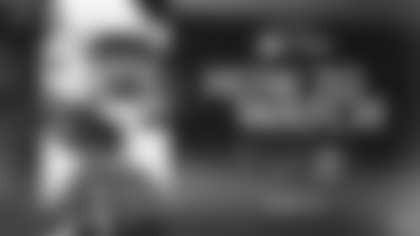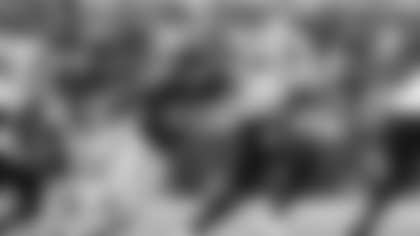A few 7's (l to r):The Lions took WR Roy Williams seventh in 2004, Thomas Jones was the pick the last time the Cards chose seventh, the 49ers grabbed DE Aldon Smith in 2011.
When the Cardinals roll the dice in next week's NFL Draft, they hope it'll land on a jackpot.
Well, they might be in just the right position to do that.
They pick seventh in the first round April 25, a place they've only selected from twice before. In 2000, the Cardinals chose running back Thomas Jones and in 1974 they drafted tight end J.V. Cain. Overall, the seventh pick has produced some highlights and lowlights in the last decade.
Minnesota chose running back Adrian Peterson at No. 7 in 2007, and last year he went on to be named MVP. San Francisco drafted linebacker Aldon Smith in 2011, Jacksonville picked up quarterback Byron Leftwich at seven in 2003 and the Vikings anchored their offensive line in 2002 with tackle Bryant McKinnie.
Yet in back-to-back years the seventh pick produced two wide receivers who failed to live up to the first-round hype when Detroit took Roy Williams in 2004 and Minnesota drafted Troy Williamson a year later.
Minnesota leads the league with three picks at No. 7 since 2002. Oakland is second with two. Since 2002, five picks, including the last three, have been defensive players and the other six offensive.
2012
No. 6: Morris Claiborne, CB, Dallas
No. 7: MARK BARRON, DB, TAMPA BAY
No. 8: Ryan Tannehill, QB, Miami
Quarterback was the position du jour in last year's first round. After Andrew Luck and Robert Griffin III went off the board first and second, respectively, two other signal callers were chosen, Ryan Tannehill at No. 8 and Brandon Weeden at 22nd. But the rest of the round wasn't stockpiled with sure things. Barron, the seventh pick, was third on the Buccaneers with 88 tackles, and also had one interception. Two picks after Barron, the Carolina Panthers chose Luke Kuechly, who was named the defensive rookie of the year.
2011
No. 6: Julio Jones, WR, Atlanta
No. 7: ALDON SMITH, LB, SAN FRANCISCO
No. 8: Jake Locker, QB, Tennessee
The 49ers missed out on solidifying their receiving corps for the foreseeable future by one pick when Julio Jones was taken off the board at No. 6. So they went for linebacker Aldon Smith, leaving three quarterbacks (Jake Locker, Blaine Gabbert and Christian Ponder) to be taken in the next five choices.
2010
No. 6: Russell Okung, T, Seattle
No. 7: JOE HADEN, CB, CLEVELAND
No. 8: Rolando McClain, MLB, Oakland
In a draft that saw Tim Tebow jump into the first round, the talent left on the board after the seventh pick has been making more of an impact every year. Haden had six interceptions his rookie season, none in 2011 and then three last year. But defensive up-and-comers such as free safety Earl Thomas and defensive end Jason Pierre-Paul went middle of the round. And late in the round, three pass-catchers went in a stretch of four picks: tight end Jermaine Gresham and receivers Demaryius Thomas and Dez Bryant.
2009
No. 6: Andre Smith, T, Cincinnati
No. 7: DARRIUS HEYWARD-BEY, WR, MARYLAND
No. 8: Eugene Monroe, T, Jacksonville
This was the year of the receiver. Five receivers were chosen after Oakland, which lined up seven quarterbacks to in Heyward-Bey's four seasons with the team, made its pick at No. 7, including Michael Crabtree, Jeremy Maclin, Percy Harvin, Hakeem Nicks and Kenny Britt. This was also the year of the Blind Side, as Michael Oher, of Hollywood fame, was chosen 23rd. On the other side of the ball, linebackers Brian Cushing and Clay Matthews were drafted in the final 17 picks.
2008
No. 6: Vernon Gholston, LB, New York Jets
No. 7: SEDRICK ELLIS, DT, NEW ORLEANS
No. 8: Derrick Harvey, DE, Jacksonville
After the midway point of the first round, Baltimore chose a tall, lanky quarterback out of Delaware. Joe Flacco led them to a Super Bowl championship in February. Short on superstars, the first round produced a slew of consistent choices. Jerod Mayo went 10th that year. Two recently-added Cardinals, running back Rashard Mendenhall and cornerback Antoine Cason were chosen in the first round.
2007
No. 6: LaRon Landry, SS, Washington
No. 7: ADRIAN PETESRON, RB, MINNESOTA
No. 8: Jamaal Anderson, DE, Atlanta
Of all the No. 7 picks from the last decade, only one has produced an MVP. The Vikings took Adrian Peterson and there hasn't been any competition for the best choice that year. Five picks later another power back was taken, when Marshawn Lynch went 12th. Safety LaRon Landry, linebacker Patrick Willis and cornerback Darrelle Revis were the defensive highlights of this draft, which included quarterback Brady Quinn.
2006
No. 6: Vernon Davis, TE, San Francisco
No. 7: MICHAEL HUFF, SS, OAKLAND
No. 8: Donte Whitner, SS, Buffalo
A pick before Michael Huff was taken seventh, one of the league's best tight ends was secured by the 49ers. One spot after the Cardinals chose Matt Leinart, the Broncos picked up Jay Cutler. The rest of the draft board was stocked with names that are very familiar to fans such as Chad Greenway, Bobby Carpenter, Antonio Cromartie, Tamba Hali, Santonio Holmes, DeAngelo Williams and Mathais Kiwanuka – and that was just in the final 14 picks.
2005
No. 6: Adam "Pacman" Jones, CB, Tennessee
No. 7: TROY WILLIAMSON, WR, MINNESOTA
No. 8: Antrel Rolle, DB, Arizona
Widely considered one of the draft's biggest busts, Troy Williamson was chosen ahead of the likes of DeMarcus Ware, Shawne Merriman, Roddy White, Health Miller and Logan Mankins. Then, at 24, buried deep in the first round, was the gem of this year's draft: Aaron Rodgers. The board wasn't stocked with wide receiver talent and was strong on running backs, as three went in the first five.
2004
No. 6: Kellen Winslow, TE, Cleveland
No. 7: ROY WILLIAMS, WR, DETROIT
No. 8: DeAngelo Hall, CB, Atlanta
As long as people talk about the 2004 first round, Roy Williams will have to compete for attention when it comes to wide receivers. Four places ahead of him, the Cardinals selected Larry Fitzgerald. Years before the Lions chose Matthew Stafford, they passed on two-time Super Bowl champion Ben Roethlisberger, who was chosen 11th and All-Pro running back Steven Jackson, who went 24th. Among the other impact players in the draft were Jonathan Vilma, Will Smith and Vince Wilfork.
2003
No. 6: Johnathan Sullivan, DT, New Orleans
No. 7: BYRON LEFTWICH, QB, JACKSONVILLE
No. 8: Jordan Gross, T, Carolina
Byran Leftwich, the second quarterback taken in the first round, was the best signal caller left when he went off the board. Following him were Kyle Boller and Rex Grossman. The board was stocked with defensive ends, but 10 years later, Terrell Suggs, Troy Polamalu, Ty Warren, Marcus Trufant and Nnamdi Asomugha were the preeminent defenders from the draft. Willis McGahee was also part of this class.
2002
No. 6: Ryan Sims, DT, Kansas City
No. 7: BRYANT McKINNIE, T, MINNESOTA
No. 8: Roy Williams, FS, Dallas
The first of three Minnesota picks had at No. 7 over the next decade went to Bryant McKinnie. Yet four picks later started a stretch of players who have carved out solid careers. Dwight Freeney went 11th, followed by Donte' Stallworth at 13th, Jeremy Shockey at 14th and Albert Haynesworth at 15th. The class also included Ed Reed, who won a Super Bowl in February.














